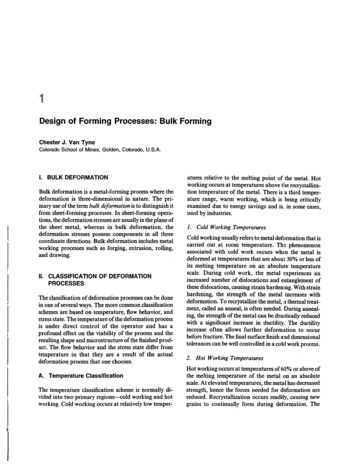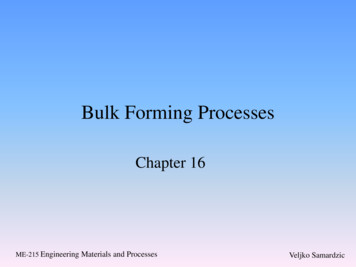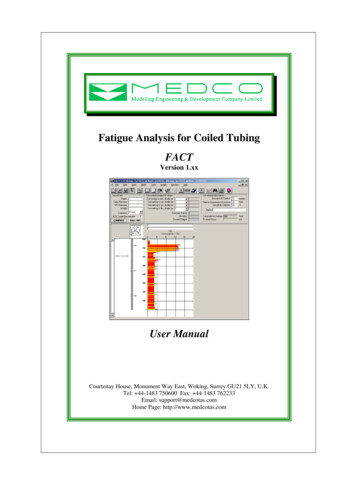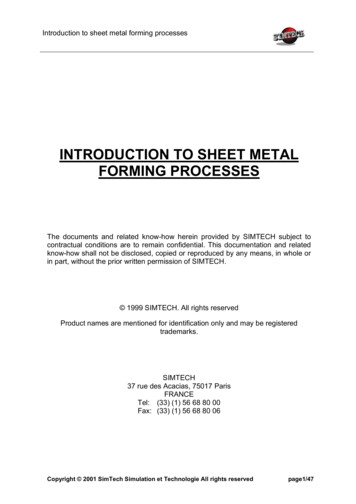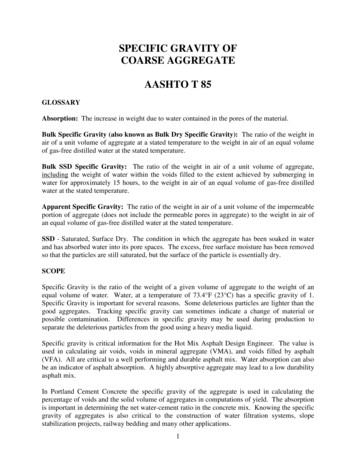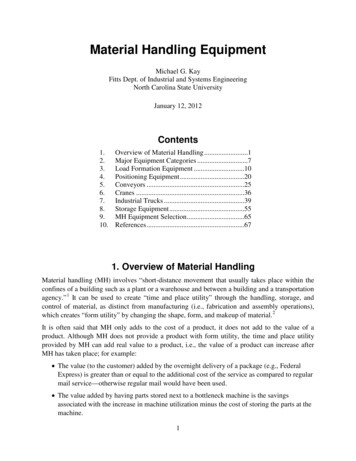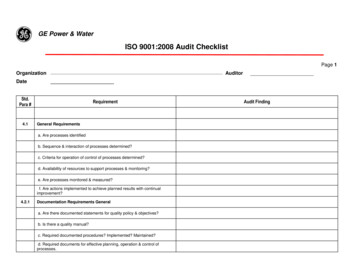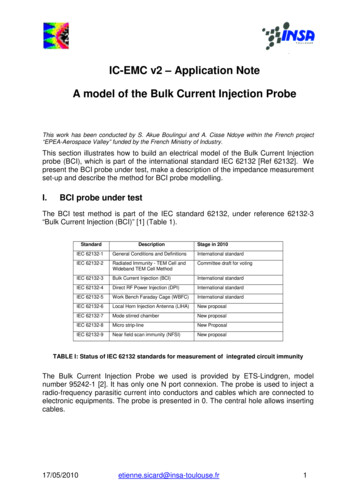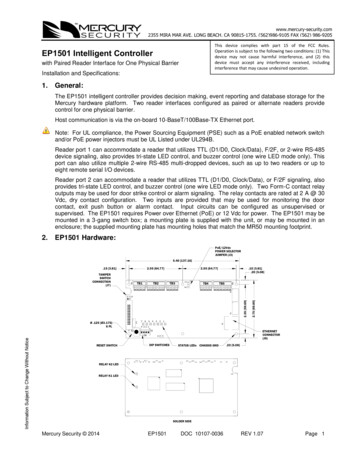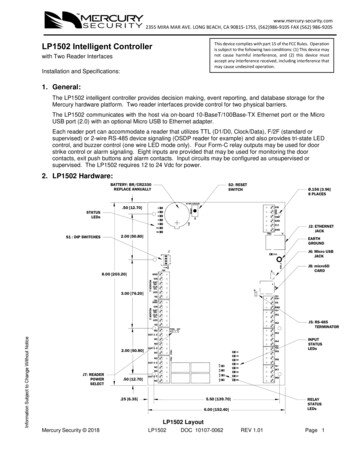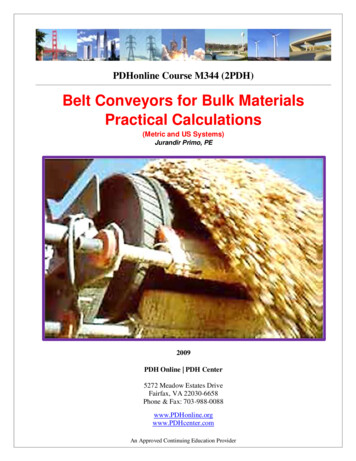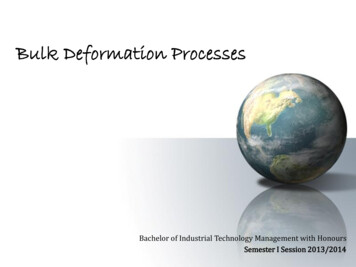
Transcription
Bulk Deformation ProcessesBachelor of Industrial Technology Management with HonoursSemester I Session 2013/2014
TOPIC OUTLINE What is Bulk Deformation? Classification of Bulk Deformation Processes Types of bulk deformation processes Forging Extrusion Drawing Rolling
LESSON OUTCOMES1. Able to differentiate between the hot, warm andcold working of bulk deformation.2. Able to explain the bulk deformation processes.
What Is Bulk Deformation? Operations that induce shape changes on the metalwork piece by plastic deformation under forces appliedby various tools and dies. Starting forms: cylindrical bars and billets, rectangularbillets and slabs, and similar shapes. These processes work by stressing metal sufficiently tocause plastic flow into desired shape. The cross-section of work piece changes without volumechange. Advantages:1. Produces common shapes inexpensively.2. Good mechanical properties.
What Is Bulk Deformation?
Classification Of BulkDeformation ProcessesCold Working Metal forming performed at room temperatureAdvantagesDisadvantagesBetter accuracyHigher forces and powerBetter surface finishLimitations to the amount of formingHigh strengthAdditional annealing for some materialis requiredHardness of the partSome material are not capable of coldworkingNo heating is required
Classification Of BulkDeformation ProcessesWarm Working Metal forming performed at temperature above the room temperaturebut below the recrystallization conditionAdvantagesDisadvantagesLower forces and powerSome investment in furnaces is neededMore complex part shapesNo annealing is required
Classification Of BulkDeformation ProcessesHot Working Involves deformation of pre-heated material at temperature above therecrystallization temperatureAdvantagesDisadvantagesBig amount of forming is possibleLower accuracy and surface finishLower forces and power arerequiredHigher production costForming of materials with lowductilityShorter tool lifeNo hardening work - no additionalannealing is required
Types Of BulkDeformation ProcessesForging The work piece is compressed between two opposing dies so thatthe die shapes are imparted to the work.Extrusion The work material is forced to flow through a die opening taking itsshape.Drawing The diameter of a wire or bar is reduced by pulling it through a dieopening (bar drawing) or a series of die openings (wire drawing).Rolling Compressive deformation process in which the thickness of a plateis reduced by squeezing it through two rotating cylindrical rolls.
Types Of BulkDeformation Processes
Forging Process in which the work is compressed between twodies / mould Some finishing operations are necessary Dies and equipment costs are high Involves moderate to high labor costs Require moderate to high operator skills Three types of forging:1. ŒOpen-die forging2. Impression-die forging3. ŽFlash-less forging
Forging
ForgingOpen-die forging Known as upsetting, it involves compression of a workbetween two flat dies or platens. Operations reduces height and increases diameter ofwork.
ForgingAdvantages:1. Simple and inexpensive dies2. Wide range of part sizes3. Good strength characteristics4. Generally for small quantitiesDisadvantages:1. Limited to simple shape2. Difficult to hold close tolerances3. Machining to final shape necessary4. Low production rate
ForgingBarreling : caused by frictional forces at the die-work piece interfaces.Can be minimized by effective lubricant.
ForgingCogging : thickness of a bar is reduced by successive forging steps atspecific intervals.Open-die forging of a multi diameter shaft
ForgingImpression-die forging Work piece takes the shape of die cavity while beingforged between two shaped dies. Carried out at elevated temperatures for enhancedductility of the metals and to lower the forces. Some of the material flows radically outward to form aflash.
ForgingStages (from bottom to top) in theformation of a crankshaft by hotimpression-die forging
ForgingClosed-die / Flashless forging Work material is completely surrounded by the die cavityduring compression and no flash is formed. Best suited to part geometries that are simple andsymmetrical.Work volume must equal the space in the die cavity toa very close tolerance.
Extrusion Work is forced to flow through a die opening to produce a desiredcross-sectional shape.Used to produce long parts of hollow or solid uniform crosssections.Products then cut to the desired lengths.Aluminium, copper, steel, magnesium and plastics are most suitablefor extrusion.Moderate to high die and equipment cost.Low to moderate labor costs and operator skill.Depending on the ductility of the material used, extrusions can becaries out various in ways:1. Hot extrusion2. Cold extrusion
ExtrusionAdvantages:1. Variety of shapes possible, especially in hot extrusion.2. Grain structure and strength enhanced in cold and hot extrusion.3. Close tolerances possible, especially in cold extrusion.4. In some operations, little or no waste of material.Disadvantages:1. Part cross-section must be uniform throughout length.2. Service life of extrusion tooling is shorter because of high contactstresses and slip rates.3. Relatively high tooling costs.4. Cost of extrusion are generally greater as compared to othertechniques.
ExtrusionHot Extrusion Carried out at elevated temperatures in 2 situations:1. For metals and alloys that do not have sufficient ductility at roomtemperature.2. To reduce the forces required. Die wear can be excessive and cooling of the hot billet in the chamber canbe a problem, which results in highly non-uniform deformation. To reduce cooling of the billet and to prolong die life, extrusion dies may bepreheated.Cold Extrusion Metals worked possess the plasticity necessary (high degree of ductility) forsuccessful forming without heating them. Done to improve the physical properties of a metal and to produce afinished part. It is fast, no wastes or little materials and gives higher accuracy andtolerance.
ExtrusionDirect Extrusion Billet is placed in the container and a ram towards the die pushes it. Metal slides along the walls of the container and is forced to flowthrough die opening. At the end of the extruding operation, a small piece of metal, calledbutt-end scrap, remains in the container and cannot be extruded.
ExtrusionIndirect / Hydrostatic Extrusion Die is mounted on the end of a hollow ram and enters the container. The outer end of container being closed by a closure plate. As the ram travels, the die applies pressure on the billet and thedeformed metal flows through the die opening in the directionopposite to the ram motions and the product is extruded through thehollow ram.
ExtrusionIndirectHydrostaticLateral
Drawing Production of long rod, wire and tubing with round orvarious cross-section than extrusions by pulling thematerial through a die opening. Similar to extrusion except work is pulled through die indrawing (it is pushed through in extrusion).
DrawingDrawing Practice: Usually performed as cold working Most frequently used for round cross-sectionsProducts: Wire : electrical wire; wire stock for fences, coat hangers andshopping carts Rod stock : nails, screws, rivets, and springs Bar stock : metal bars for machining, forging and other processesWire Drawing vs Bar Drawing Difference is the stock size: Bar drawing - large diameter bar and rod stock Wire drawing - small diameter stock - wire sizes down to 0.03mm (0.001 in.) are possible
Rolling Process of reducing the thickness or changing the crosssection of a work-piece by compressive forces exertedby a pair of rotating rolls. Products: plates & sheets - plates are used for structuralapplications like bridges, ships and nuclear vessels whilesheets (generally 6mm or less in thickness) are used forautomotive, beverage cans, office & kitchen equipment.
RollingSteps of Rolling The preheated at 1200oC cast ingot is rolled into one of the threeintermediate shapes called:1. Bloom – square cross-section of 150/150 mm or more2. Slab – 40/250 mm or more is rolled from an ingot or a bloom3. Billet – 40/40 mm or more is rolled from a bloom Then they are rolled into a different products.
Rolling
RollingBasic types of rolling1. Shape Rolling Work is deformed by a gradual reduction into a contoured crosssection (I-beams, L-beams, U-channels, rails, round, square barsand rods, etc.).2. Ring Rolling Thick-walled ring of small diameter is rolled into a thin-walledring of larger diameter.
Shape Rolling
Rolling3. Thread Rolling Threads are formed on cylindrical parts by rolling them betweentwo thread dies.4. Gear Rolling Gear rolling is similar to thread rolling with three gears (tools)that form the gear profile on the work.
Metal forming performed at temperature above the room temperature but below the recrystallization condition . Classification Of Bulk Deformation Processes Advantages Disadvantages Big amount of forming is possible Lower accura
